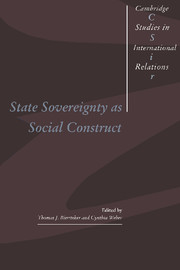Book contents
- Frontmatter
- Contents
- List of figures
- List of contributors
- Acknowledgments
- 1 The social construction of state sovereignty
- 2 Contested sovereignty: the social construction of colonial imperialism
- 3 Beyond the sovereignty dilemma: quasi-states as social construct
- 4 The sovereign state system as political-territorial ideal: historical and contemporary considerations
- 5 Sovereignty and the nation: constructing the boundaries of national identity
- 6 Sovereignty, nationalism, and regional order in the Arab states system
- 7 Binding sovereigns: authorities, structures, and geopolitics in Philadelphian systems
- 8 Hierarchy under anarchy: informal empire and the East German state
- 9 Reconstructing the analysis of sovereignty: concluding reflections and directions for future research
- Index
- Titles in the series
4 - The sovereign state system as political-territorial ideal: historical and contemporary considerations
Published online by Cambridge University Press: 01 June 2011
- Frontmatter
- Contents
- List of figures
- List of contributors
- Acknowledgments
- 1 The social construction of state sovereignty
- 2 Contested sovereignty: the social construction of colonial imperialism
- 3 Beyond the sovereignty dilemma: quasi-states as social construct
- 4 The sovereign state system as political-territorial ideal: historical and contemporary considerations
- 5 Sovereignty and the nation: constructing the boundaries of national identity
- 6 Sovereignty, nationalism, and regional order in the Arab states system
- 7 Binding sovereigns: authorities, structures, and geopolitics in Philadelphian systems
- 8 Hierarchy under anarchy: informal empire and the East German state
- 9 Reconstructing the analysis of sovereignty: concluding reflections and directions for future research
- Index
- Titles in the series
Summary
A whole history remains to be written of spaces – which would at the same time be the history of powers (both of these terms in the plural) – from the great strategies of geopolitics to the little tactics of the habitat.
Michel FoucaultFrom the perspective of the late twentieth century, the territorial structure of the international state system appears to be one of the great constants in human affairs. Faith in the stability of the system has been shaken somewhat by the breakup of the Soviet Union and Yugoslavia, but few observers seriously question the system itself. People generally accept the assumption that the land surface of the earth should be divided up into discrete territorial units, each with a government that exercises substantial authority within its own territory. There may be disagreement over how much authority state leaders should have, but it is generally assumed that the political map of the future will look much like that of today, aside from some adjustments in certain unstable areas.
Assumptions about the constancy of the dominant political-territorial order are not the sole province of more casual analysts of the political world; they pervade the academic literature on politics and government as well. It is true that some scholars are raising questions about the implications for the sovereign authority of state leaders of growing economic interdependence and the internationalization of environmental protection and human rights.
- Type
- Chapter
- Information
- State Sovereignty as Social Construct , pp. 81 - 120Publisher: Cambridge University PressPrint publication year: 1996
- 119
- Cited by

